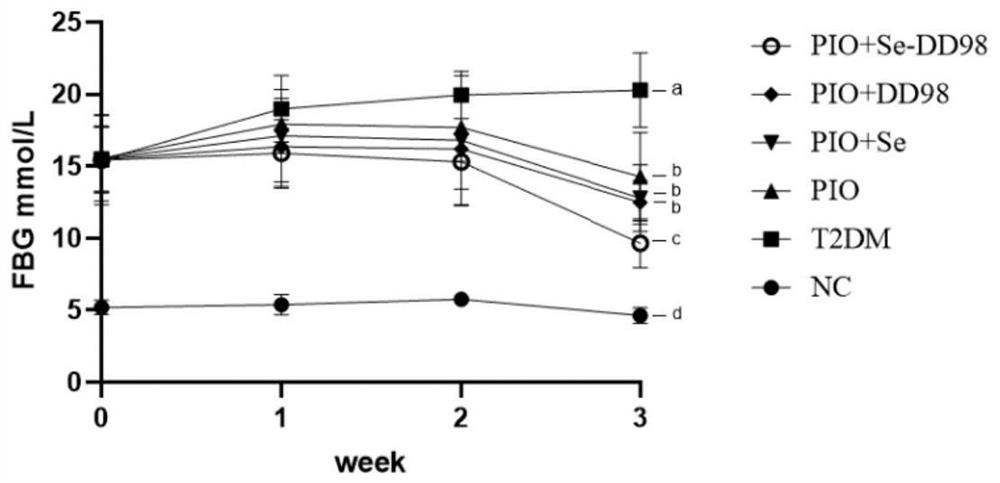Drug combination composition for type 2 diabetes and liver injury and application of drug combination composition
A type 2 diabetes and combined drug technology, applied in the field of biomedicine, can solve the problems that the gain effect has not been further verified, and there is no detailed report
- Summary
- Abstract
- Description
- Claims
- Application Information
AI Technical Summary
Problems solved by technology
Method used
Image
Examples
Embodiment 12
[0075] Example 1 Construction of type 2 diabetes mouse model and combined drug detection
[0076] 1. Preparation of Se-enriched Bifidobacterium longum DD98
[0077] RCM modified medium: beef extract 1%, peptone 0.5%, yeast powder 0.3%, glucose 0.6%, sodium chloride 0.5%, anhydrous sodium acetate 0.3%, L-cysteine hydrochloride 0.05%, agar 1.5 -1.8%.
[0078] Preparation method: inoculate the Bifidobacterium longum DD98 strain (the preservation number of the Bifidobacterium longum DD98 strain is CGMCC No. 16573) into the RCM modified medium, and after anaerobic cultivation at 37°C for 12 hours, add selenium to the medium Na2SO4 (concentration: 18.5 μg / mL), continued to cultivate for 24 hours, kept the pH value at 6.8, and fermented in a high-selenium environment to prepare selenium-enriched DD98 fermentation broth.
[0079] The detection method of selenium content in Se-DD98 fermentation broth refers to the national standard GB5009.93-2010 "Determination of Selenium in Food"...
Embodiment 2
[0082] Embodiment 2 Changes in food intake and body weight of mice
[0083] The food intake of the mice was detected every week, and the average daily food intake of the mice in each group was calculated during the administration period. After the mice were fasted for 12 hours, the fasting body weight of the mice was weighed. figure 1 is the detection result of the food intake of the mice, figure 2 It is the result of fasting weight change of mice.
[0084] Depend on figure 1 It can be seen that the food intake of the mice in the T2DM group was significantly increased compared with that in the NC group (p<0.05), which was in line with the characteristics of diabetic polyphagia. Compared with the T2DM group, the food intake of the mice in each administration group was reduced. Compared with the PIO group, the food intake of the PIO+Se group and the PIO+DD98 group did not decrease significantly, but the combination of selenium-enriched DD98 and pioglitazone could significan...
Embodiment 3
[0087] Example 3 Changes in Fasting Blood Glucose in Mice
[0088] The mice were fasted for 12 hours, and the blood was collected from the tail to detect the fasting blood glucose, and the blood glucose was detected every week during the 3 weeks of administration. image 3 It is the change result of fasting blood glucose (FBG) of mice.
[0089] Depend on image 3 It can be seen that the fasting blood glucose value of the mice after modeling is greater than 11.1mmol / L, which proves that the type 2 diabetes model is successful. There was no significant difference in the fasting blood glucose of the mice in each model group when grouping, and the fasting blood glucose of the mice with type 2 diabetes continued to rise after 1 week of administration. Compared with the T2DM group, the PIO group, PIO+Se group, PIO+DD98 group, PIO group The increase in fasting blood glucose in the +Se-DD98 group was alleviated, and at the second week of administration, the fasting blood glucose in al...
PUM
 Login to View More
Login to View More Abstract
Description
Claims
Application Information
 Login to View More
Login to View More - R&D
- Intellectual Property
- Life Sciences
- Materials
- Tech Scout
- Unparalleled Data Quality
- Higher Quality Content
- 60% Fewer Hallucinations
Browse by: Latest US Patents, China's latest patents, Technical Efficacy Thesaurus, Application Domain, Technology Topic, Popular Technical Reports.
© 2025 PatSnap. All rights reserved.Legal|Privacy policy|Modern Slavery Act Transparency Statement|Sitemap|About US| Contact US: help@patsnap.com



